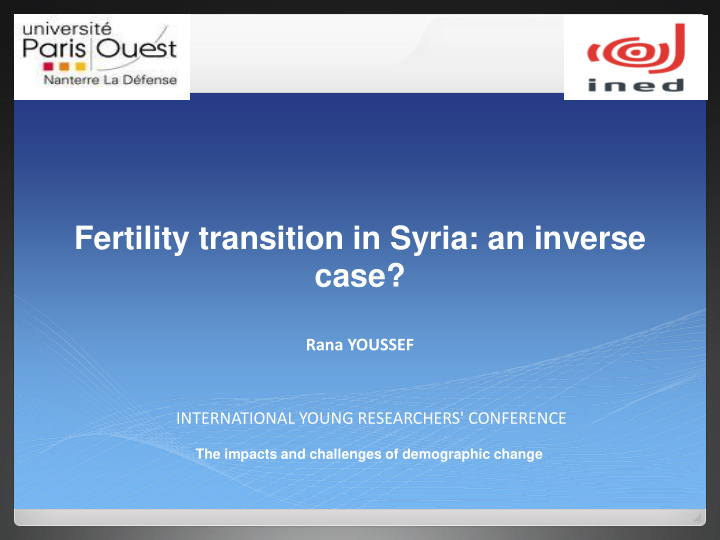



Fertility transition in Syria: an inverse case? Rana YOUSSEF INTERNATIONAL YOUNG RESEARCHERS' CONFERENCE The impacts and challenges of demographic change
Syrian context Several phases of fertility transition in Syria : The first phase of very high fertility records The phase of rapid decline in the mid-1980s The phase of low decrease or the phase of stalling fertility transition Few studies have been devoted to the question of Syrian fertility transition
Theoretical background The demographic transition theory can’t explain Syrian fertility transition The crisis led transition hypothesis proposed by Courbage in his analysis of fertility transition in Syria (Courbage 1994, 2007). Different factors have been suggested as the cause of stalling fertility transition (stability of contraceptive prevalence, decrease of mean age at first marriage for women, preference for male children … )
Study objective This study aims to review the trends and changes in fertility over the period from 1959 to 2010 and identify the factors underlying them.
Data Estimates of fertility in this study are based on birth registration data for the period 1959- 2010. Figure 1: Births registered in the year of occurrence and births registered late in Syria 1959-2010 Sources : Civil registration (Central Bureau of Statistics various years, Statistical Abstracts).
Data Table 1: Birth registration coverage in Syria, 1956-2004 Period Births of Syrians Births registered at the Coverage of birth observed from censuses civil registration registration 1956-1960 1004054 573000 57.07 1966-1970 1336425 923017 69.07 1977-1981 1824613 1632044 89.45 1990-1994 2070008 1993298 96.29 2000-2004 2488125 2330575 93.67 Sources : Author's calculations based on the 1960, 1970, 1981, 1994 and 2004 census, and civil registration (Central Bureau of Statistics various years, Statistical Abstracts).
Fertility estimates Adjustment of births Distribution of late registered births Births correction taking account of mortality Estimate of women aged 15-49 years Estimate of fertility rates
Total fertility rate Figure 2: Total fertility rate in Syria 1959-2010 Sources: Author's calculations
Fertility estimates Figure 3: Age-specific fertility rates in Syria, 1980-2010 Sources : Author's calculations
Decomposition of fertility changes The change in the TFR can be decomposed into two components : 1. Changes in nuptiality 2. Changes in marital fertility Each of these components is further broken down by five-year age group between 15 and 49.
Decomposition of fertility changes Table 2: Decomposition of the change in total fertility rate, Syria Period Age group 15-19 20-24 25-29 30-34 35-39 40-44 45-49 Total Between 1980-1985 and 1985-1990 Nuptiality -0.07 -0.11 -0.07 -0.03 -0.01 0.00 0.00 -0.30 Marital fertility -0.05 -0.16 -0.15 -0.21 -0.22 -0.14 -0.06 -1.01 Total -0.13 -0.27 -0.23 -0.24 -0.23 -0.14 -0.06 -1.31 TFR decreased by 1.31 from 8.14 to 6.83 Between 2000-2005 and 2005-2010 Nuptiality -0.04 -0.05 -0.04 -0.03 -0.01 0.00 0.00 -0.17 Marital fertility 0.02 0.09 0.10 0.02 -0.04 -0.03 -0.05 0.11 Total -0.02 0.04 0.06 -0.01 -0.05 -0.04 -0.05 -0.07 TFR decreased by 0.07 from 4.63 to 4.56 Sources : Author's calculations
Conclusion A spectacular fertility decline in the second half of the 1980s: the total fertility rate declined by more than 39 % between 1985 and 1994. An inversing trend; the fertility rate started to increase since 2007 to reach exactly the same level as the early 2000s. Age-specific fertility rates declined substantially in all age groups during the second half of the 1980s. While during the recent decade, an increase in fertility at younger ages was observed.
Conclusion Changes in fertility were mainly attributable to changes in marital fertility during each of the periods examined. More than 81 % of the decline in fertility was due to the decrease in marital fertility during the period 1985-1995, nuptiality was responsible for only 18.75% of this decline. During the last decade, the stability of the fertility rate at 4.7 children per women was the result of two countervailing factors trends: A continuing decline in proportion of married women at younger and central ages An increase in marital fertility among women of these ages (reduced contraceptive prevalence, stability of desired number of children, low levels of employment)
Thank you
Recommend
More recommend